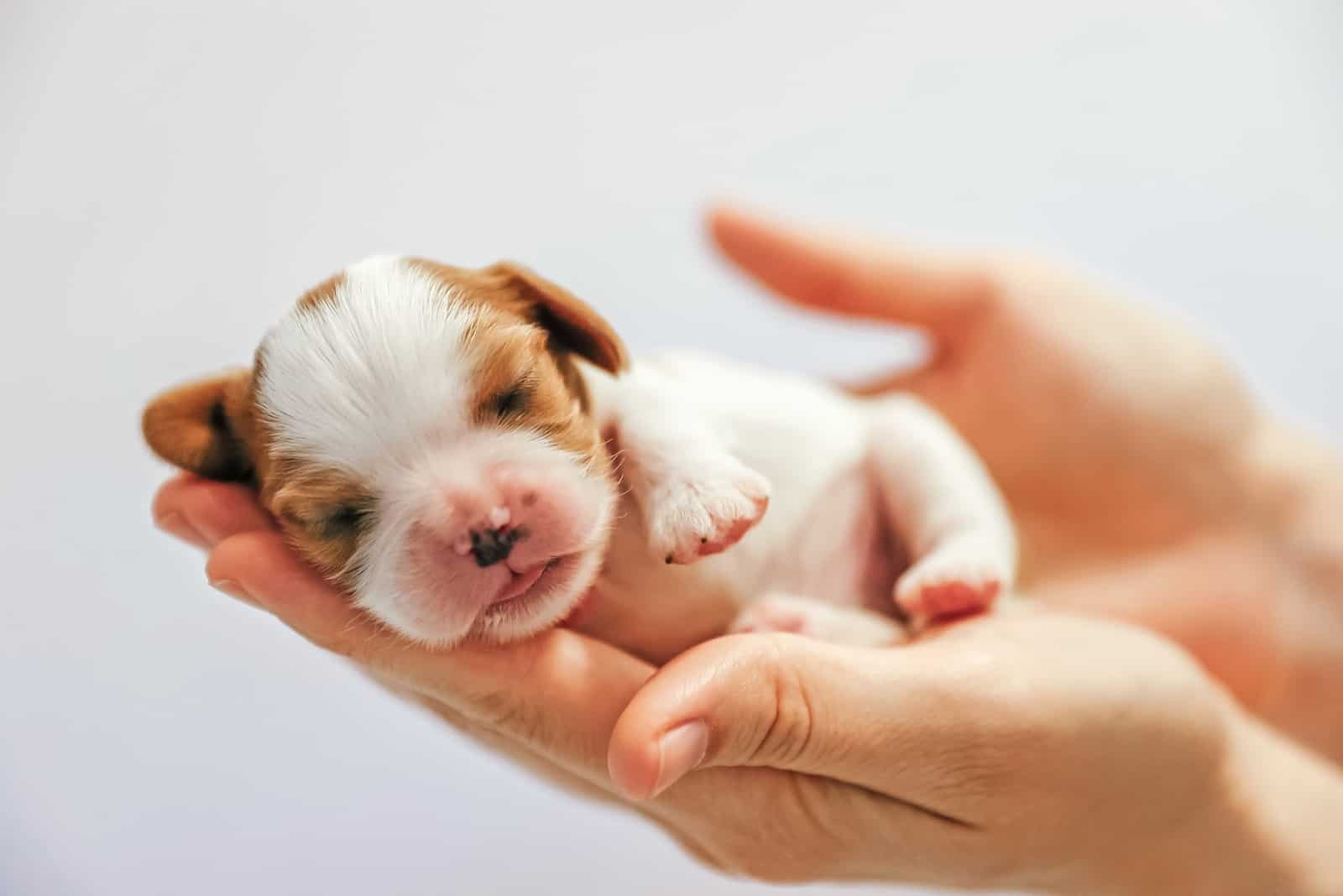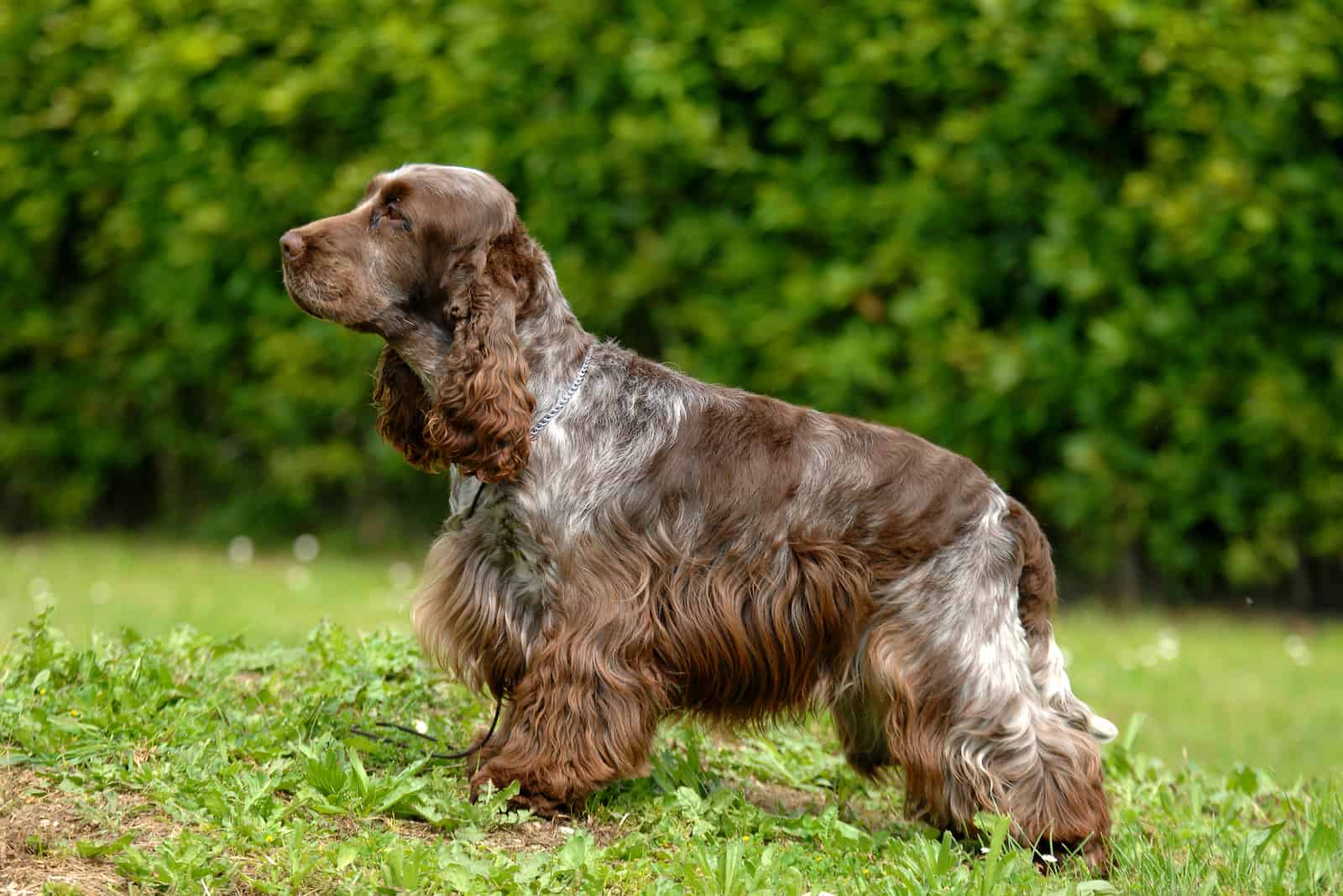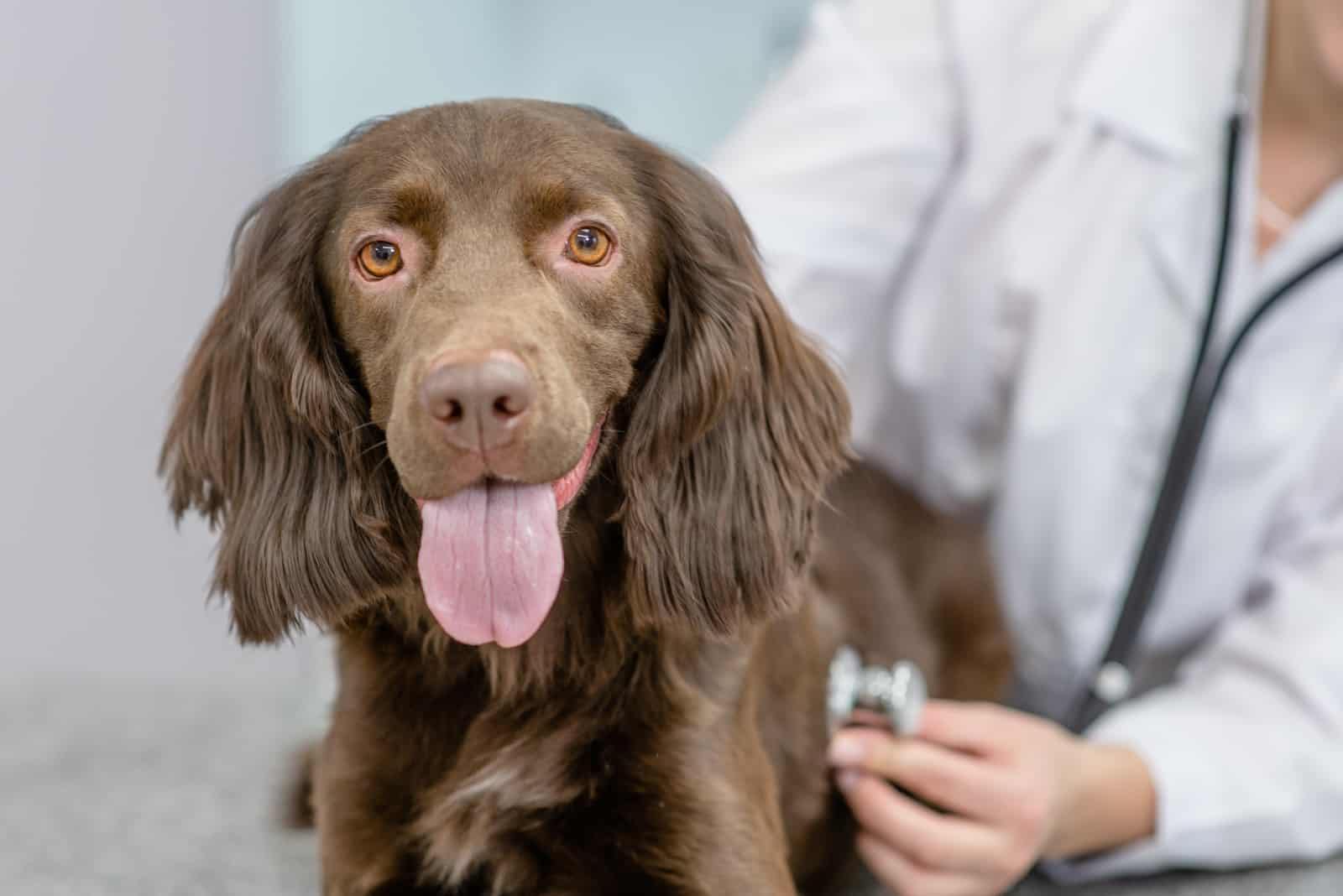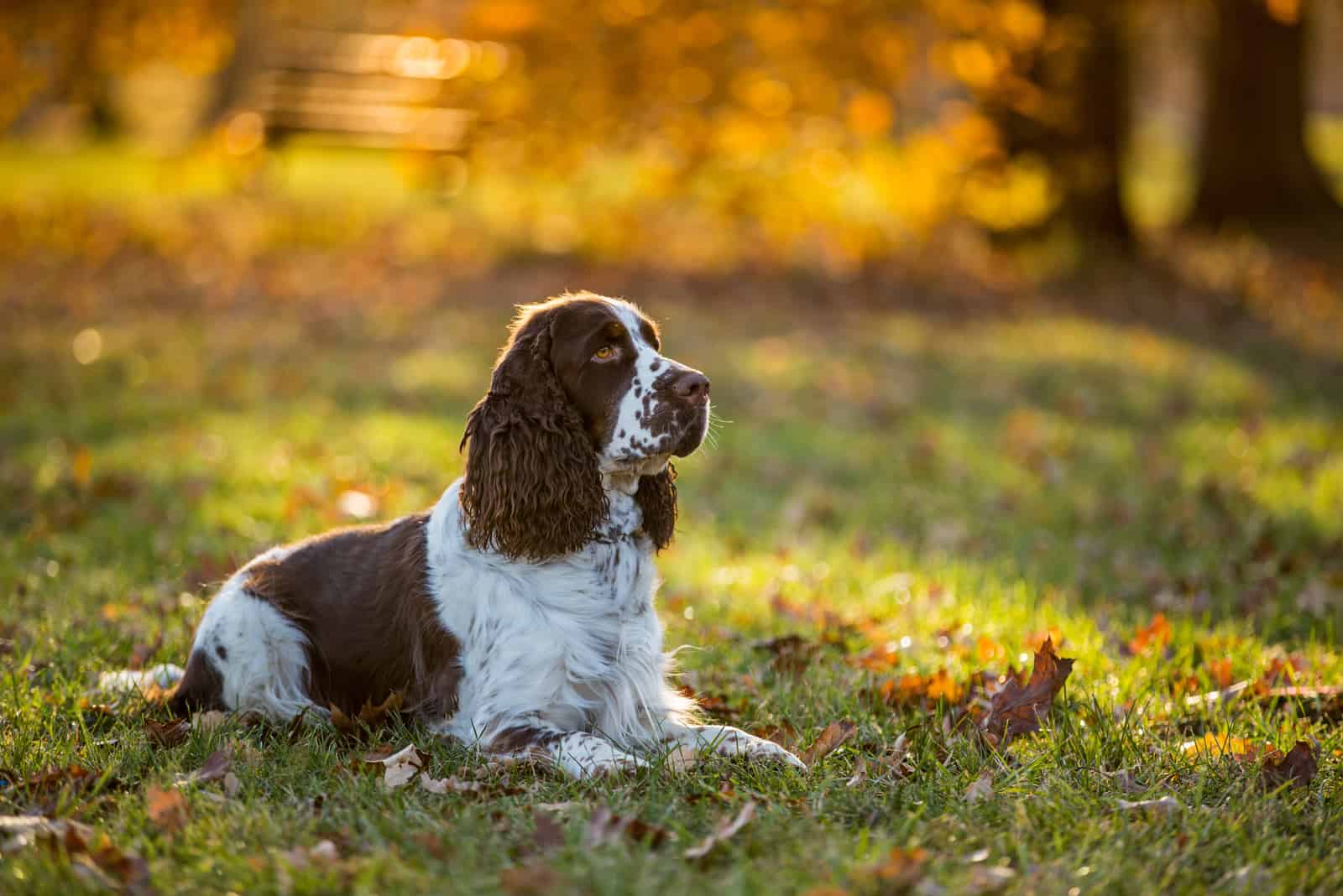The Cocker Spaniel is a medium-sized, purebred dog originating from England.
Medium-sized dogs usually weigh between 20 and 60 pounds, and their height ranges between eight inches and 27 inches.
Cocker Spaniels fall right in the golden middle, reaching 15 inches in height, and weighing around 30 pounds on average.
Back in the day, Cocker Spaniels were used to hunt wild birds in different environments, such as dense forests and bushes in England.
Keeping that in mind, Cocker Spaniels are hunting dogs with a high prey drive. They need regular exercise and playtime, especially when you consider their predisposition for becoming obese.
In this article, we’re going to talk about how big a Cocker Spaniel will become from its first days of life to its adulthood.
We are also going to be mentioning the major factors that affect the puppy’s growth. These factors aren’t only meant for Cocker Spaniels, but for all other dogs as well!
Let’s find out more about the Cocker Spaniel’s growth chart and its journey to becoming an adult, independent doggo that needs all the cuddles it can get!
Cocker Spaniel Puppy Growth Chart

To start off, we will be saying something about the Cocker Spaniel growth chart in puppies. After all, this is the first stage of life, and we have to start somewhere.
The little ones usually have higher requirements when it comes to feeding and environment. Therefore, it’s important that they’re always with their mother in a soft and warm space.
Puppies need to nurse in their first weeks of life. It’s especially important that they start nursing as soon as possible, following their birth.
Their mother’s milk will provide them with needed nutrients to help them grow into healthy adults. Let’s check out the growing process of a Cocker Spaniel puppy.
Here’s how it goes!
Stages Of A Cocker Spaniel’s Puppyhood
Newborn Cocker Spaniel puppies will likely come in different sizes. A mother Cocker Spaniel can carry three or even 12 puppies in one litter!
So, having different-sized puppies in the litter isn’t necessarily something one should worry about. It’s quite an often occurrence.
The Cocker Spaniel mother will already start weaning her puppies around three to four weeks of age. That’s about the time when they’ll start being independent small dogs.
Let’s see how their development goes from day one to reaching adulthood.
Stage 1: Welcome To The World, Little One!

Newborn Cocker Spaniel puppies are born weighing only eight to 10 ounces!
So, within their first week of life, with proper nutrition and maintenance, healthy puppies will grow to almost double that. Within week one, Cocker Spaniel puppies will weigh around 14 to 15 ounces.
Each week, Cocker Spaniel puppies will grow 7.5 to 9 ounces in weight. As they gain more weight, they will get bigger in size.
Stage 2: What happens during the first month?
Well, quite a lot, actually!
Within the first month of life, Cocker Spaniel puppies will grow very fast and change in size. Not only will they change in size, but they’ll also grow their first teeth, start lifting themselves up, and communicate with one another through mini barks and whining.
A Cocker Spaniel’s teeth start growing as early as two weeks of age, and they usually open their eyes around three weeks of age. Some puppies will open their eyes sooner, some will later.
By the end of the first month, Cocker Spaniel puppies will weigh between 2.8 and 3.5 pounds.
Stage 3: Growing fast!

Looking back on the first month of their lives, Cocker Spaniels start to gain more confidence each day.
The period after the first four weeks is a time when Cocker Spaniel puppies start investigating their whereabouts and start chewing everything they can get their little teeth on.
Reaching eight weeks of age, or should we say, two months, Cocker Spaniel Puppies gain up to 6.5 pounds in weight.
Stage 4: Almost grown up.
A six-month old Cocker Spaniel should already weigh about 13 to 22 pounds, meaning they are half of their way of reaching their full size.
Perhaps this period is a bit difficult for owners, especially for first-time owners who are dealing with a now adolescent Cocker Spaniel puppy.
During this period, the little rascals will be all over the place, exploring and getting to know the world around them.
Therefore, it is important to have already started the socialization process and regular training.
Stage 5: Adult Cocker Spaniels.
A healthy Cocker Spaniel puppy will reach its full size when hitting adulthood, around nine to 12 months of age.
Around 10 months of age, on average, Cocker Spaniel dogs have reached their maximum size. They’re practically adults now, even though they usually don’t act like it!
So, a full grown Cocker spaniel will be anywhere between 28 and 32 pounds. This will greatly depend on the diet and exercise ratio your dog has had within the first year of its life.
Adult Cocker Spaniels will grow up to 16 inches in height.
Let’s not forget the difference in dog weight and size between a female and a male Cocker Spaniel. Females will naturally be a pound or two lighter in weight, and an inch or two smaller in height compared to their male counterparts.
Female Cocker Spaniel Growth Chart

So, keeping in mind that our female Cocker Spaniels will be a few pounds lighter and a few inches smaller than the males, let’s check out how a female Cocker Spaniel’s growth and size changes within the first year of life.
On average, a Cocker Spaniel female in the first three months should be weighing somewhere between eight and nine pounds.
When they reach their six-month birthday, their weight is expected to be around 10 pounds if it’s a smaller female. However if it’s a larger female, it should weigh around 18 pounds at the most.
Adult Female Cocker Spaniel
Cocker Spaniel female puppies will stop growing when they reach 14 months of age.
After a year, a healthy Cocker Spaniel will weigh from 15 to 23 pounds. Keep in mind that the span of 12 months sometimes doesn’t mean that this dog is fully grown.
When they’re fully mature and reach their full size, a healthy adult female Cocker Spaniel will weigh between 24 and 30 pounds.
Adult female Cocker Spaniels will usually behave very nicely and be laid-back. Most females won’t have the urge to wander away from their owner.
If a female Cocker Spaniel puppy is spayed during the first year of its age, they might have a longer time growing up, and some of their secondary sex characteristics might appear later.
Male Cocker Spaniel Growth Chart

Male individuals are slightly bigger in size than their female counterparts. This is simply the law of nature.
So, we will definitely see bigger puppies in the litter if there are male pups at birth. Regardless, some dogs of the same gender can be born smaller, and some larger.
All things considered, the weight of a young Cocker Spaniel male at three months should be between 10 and 11 pounds.
The expected weight after the first half year (six months) should be between 12 pounds for the smallest ones and around 20 pounds for the larger ones.
Adult male Cocker Spaniel Growth Chart
In the first year of their life, they should be weighing somewhere around 26 to 30 pounds.
The smaller adult male Cocker Spaniel will stop growing when it reaches 14 months of age; meanwhile, the larger ones will stop growing when they reach their 16-month birthday.
So, the average age for reaching adulthood for the adult male Cocker Spaniel is around 14 months of age.
Note that if a male has been neutered in its first year of life, reaching adulthood in this time span might be postponed due to a lack of testosterone.
Cocker Spaniel Growth Chart: Female Vs. Male

In the animal kingdom, particularly among all mammals, males are usually bigger than females. And, dogs are indeed mammals, so this rule applies to our Cocker Spaniel dog breed.
Females are usually smaller in size than their male counterparts. That being said, females are less dominant in terms of their temperament.
In contrast to that, male Cocker Spaniels have larger bodies and more defined bone structures.
Before we get further into the Cocker Spaniel growth chart, it is important to note when these adorable dogs stop growing.
What Age Do Cocker Spaniels Stop Growing?
There’s one thing you should keep in mind – each dog is an individual, meaning some will grow faster, some slower.
Some dogs might reach their adulthood a few weeks earlier, while others might postpone the responsibilities of being adult dogs.
Medium-sized Cocker Spaniel dogs usually reach their adulthood by nine months of age.
Most small dogs and medium dogs, like bulldogs, boxers, Maltese, toy poodles, King Charles and Springer Spaniels, Bichon Frise, and Border Collies take between nine and 10 months to mature.
This is not the case with large dog breeds such as the Labrador Retriever, the German Shepherd, the Golden Retriever, the Rottweiler, the Great Dane, and the Mastiff.
These large breeds’ growing-up period might last anywhere between one and 1.5 years. Even though large dogs grow very fast, their puppy-like behavior makes them look like big, adorable babies!
An adult female Cocker Spaniel will stop growing when she turns 14 months of age , whereas the adult male Cocker Spaniel will stop growing when he reaches 15 months of age.
Female dogs are, by nature, usually more mature than males, so this minor difference in the growing-up period is perfectly normal.
Cocker Spaniel puppy born too small?
There are situations when a Cocker Spaniel puppy is born too small compared to other siblings. Being the smallest in the litter, this puppy is usually underweight.
Although this can be natural in dogs, and most small puppies will develop to full size, their growing period might be delayed and out of the growth chart. That is why most dog weight charts are usually only an estimate.
However, some small newborn puppies might be a result of labor difficulties. This can prove fatal to the newborn, or it can lead to difficulties in further development. In this case, veterinary intervention and supervision are much needed.
What Affects The Cocker Spaniel’s Growth?

There are some factors to take into consideration when calculating the Cocker Spaniel’s growth chart.
Many factors can affect its growth. We have come up with four most important factors that affect a Cocker Spaniel’s growth.
All of them are in correlation with one another, meaning that a change in one factor results in a change in another.
These factors include:
• genetics and environment
• diet and nutrition
• health condition
• physical activity
Genetics And Environment: Intertwined Factors In The Cocker Spaniel Growth Chart
Genetics plays a huge role in each living organism. A dog’s weight and size are greatly influenced by genetic and environmental factors.
From the largest Great Danes to the smallest Chihuahuas, genes that moderate growth are the main culprits as to why some dogs grow super large, while others stay miniature.
One of the first things to check when making a growth chart for your dog is the size of its parent breeds. That way, you could also check if the dog has a chance of becoming affected by genetically-inherited disorders.
Reputable breeders take genetics and growth factors very seriously. By crossing the same purebred, healthy dogs, a quality bloodline is achieved. This puts the purebred dog within the breed standards, meaning they will be the perfect example of the breed.
Genetic predisposition is one of the key factors in a Cocker Spaniel’s growth and development. In other words, genetic predisposition is a term used for an organism’s susceptibility to some genetically-inherited, specific diseases. We’ll get to those later.
But, what we want for you to remember is – the genetic predisposition is greatly under the influence of environmental factors.
Why is this important?
Well, if Cocker Spaniel puppies are born healthy, but are being kept in bad conditions, they most likely won’t grow up to be healthy dogs.
The early years of life is the most important period in every dog’s life. This means that a dog’s metabolism needs all the factors it requires in order to live, grow, and survive. And, this very much includes environmental factors.
For example, your Cocker Spaniel puppy might not get enough exposure to the sun, which is one of the main sources of vitamin D needed for mental and physical development.
This dog will most likely develop health issues within the first six months of age, which is pretty early for a disease to occur.
Diet And Nutrition: A Crucial Factor In The Cocker Spaniel Growth Chart

Alongside other factors, diet and nutrition are impossible to live without.
From the very first moments of life, within the first three hours to be more precise, newborn puppies start receiving milk from their mother. Nursing is a crucial factor in their development.
Cocker Spaniel puppies stop nursing when they reach five to six weeks of age. That means they’ll start eating puppy food, and later on, adult dog food.
The best way to monitor the growth progress is to follow a diet plan and measure the dog’s weight as it grows. Write down the puppy’s weight gain in your puppy growth chart.
It’s important to provide your Cocker Spaniel with nutritious dog food. High-quality dog food will help your pooch grow up healthy and strong!
To see how much food and what kind of food should this dog eat, check the Cocker Spaniel feeding chart.
What you should also know is that some people food, as well as certain plants, can be bad for your dog. Make sure to thoroughly research what food your dog should never eat.
Health Conditions: Inherited Or Acquired Health Problems

Health conditions are closely bound to genetics and environmental factors – even more so to proper diet and nutrition.
Cocker Spaniels are known as one of the healthiest pure breeds. However, they still do have some genetically-inherited health issues.
While most won’t have many health problems during their life, some Cocker Spaniels will develop and show signs of an inherited disease.
So, this may or may not happen.
Here are some of the inherited health issues in Cocker Spaniels to keep in mind: progressive retinal atrophy, cataracts, epilepsy, luxating patella, glaucoma, and hip dysplasia.
Whether you are a first-time dog owner or an experienced dog owner, there is one thing that you should know.
As a dog owner, you are responsible for your dog’s health condition. This does not only mean treating it for a disease when it develops. What it primarily means is that you should make sure to do your best in order to prevent a disease from happening.
How will I prevent a disease from happening?
Preventing a disease includes taking your puppy to the vet and making sure that it has received all of its needed vaccinations, deworming treatments, and checkups.
Later on, provide your new best friend with high-quality puppy food, and take him out to have some fun in the sun!
Have an everyday walking and exercise plan, which will build a good path in raising a happy and healthy dog.
Proper maintenance can prevent lots of disorders and diseases from occurring. And, knowing which health issues your purebred Cocker Spaniel might be prone to is one of the first things you should consider when raising a puppy.
Can neutering/spaying have an effect on a Cocker Spaniel’s growth?
Testosterone is a hormone that is largely responsible for the growth of male puppies. Neutering in the first year of life can lead to the disruption of the growth process, which can bring unwanted health issues later on.
The same goes for female puppies, except it’s estrogen that’s responsible for their growth. Spaying can also lead to complications during puppy growth if done in the first year of life.
So, it is better to wait for a while before having them spayed or neutered.
On the other hand, there are more beneficial sides of neutering. One of those more beneficial sides of neutering includes a lower chance of prostate cancer and less aggressive behavioral patterns. It can also lead to a more affectionate and less territorial adult male Cocker Spaniel.
As for the female Cocker Spaniel, spaying leads to a smaller probability of developing uterine and breast cancer.
Most dog owners decide on this procedure because it prevents the birth of unwanted puppies. Adult Female Cocker spaniels also tend to become more laid-back after being spayed.
Physical activity

Last, but not least, is physical exercise and activity.
This is closely linked to diet and nutrition factors, and this is why. An imbalanced diet, paired with a lack of physical exercise, can make a Cocker Spaniel obese. Insufficient nutrient intake will make a Cocker Spaniel underweight and malnourished.
However, a proper diet that is packed with nutrients and proteins will greatly contribute to the development of a healthy dog.
Regular exercise is a must!
Cocker Spaniel puppies will benefit largely from regular exercise routines and quality playtime. As Cocker Spaniel puppies are small dogs in their developing phase, it is important to make sure they don’t get hurt during activity time.
It’s never a good idea for a puppy to do intense physical activity like overdoing exercise. A puppy’s heart beats faster than that of an adult, so if they are exposed to an intense workout every day, it might lead to some serious health conditions later in life.
Cocker Spaniels love to run and just simply have fun. Regular walking and running will make their body more muscular and more immune to various diseases.
Not only will their muscles improve, but the development of their bone structure will greatly benefit from the above-mentioned activities.
Now, you get the idea of why a Cocker Spaniel, like all puppies, needs to have lots of daily activity. As your Cocker Spaniel grows into an adult, some activities might not be very interesting to them.
Nevertheless, it is still important to walk and exercise your adult Cocker Spaniel dog.
American Cocker Spaniel Vs. English Cocker Spaniel: Can You Tell The Difference?
Both dog breeds carry different names, so obviously, the English and the American Cocker Spaniel are two different purebred dogs.
The main difference is their size. English Cocker Spaniels are a bit larger in size than their American Cocker Spaniel canine cousins.
Who’s The Tallest?

Reaching between 15 and 17 inches in height, English Cocker Spaniels are a bit taller compared to American Cocker Spaniels, which can reach between 13 and 15 inches in height.
This doesn’t sound like much of a difference, but when you see these two standing next to each other, it’s quite noticeable.
Not only do they differ in height, but also in body types. English Cocker Spaniels, being medium-sized dogs, have a body that is slightly more robust and muscular.
On the other hand, American Cocker Spaniels are slimmer – their bodies are more petite than their counterparts.
Other differences can be seen in the bone structure of the head. English Cocker Spaniels have longer ears and muzzle, while the American Cockers’ small head has shorter ears and muzzle.
Weight A Minute
Next up is the weight. Just like in humans, a Cocker Spaniel’s weight will depend greatly on its diet, lifestyle, gender (males usually being heavier), and overall health condition.
Healthy adult English Cockers can weigh anywhere from 26 to 34 pounds, whereas American Cocker Spaniels weigh between 20 and 30 pounds.
This is considered a healthy weight for both English and American Cocker Spaniel dogs.
You see, the ratio of height and weight is pretty good. In the first week after birth, small Cocker Spaniel puppies weigh as little as 14 ounces!
These little guys grow very fast, and by the third week, they double in weight. This is, of course, in the case of healthy Cocker Spaniel puppies.
Read Also: The Mini Cocker Spaniel: Everything You Need to Know!
Final Thoughts

Photo from: @zuri.the.cocker
Cocker Spaniels make wonderful family dogs. They’re loyal, gentle, affectionate, and fun to be around.
For your Cocker Spaniel to be like this, you need to provide him with everything he needs in order to have a healthy and happy growth.
Your Cocker Spaniel’s growth will depend on all of the factors we mentioned in this article. But, it will greatly depend on how you take care of it.
Just like plants need food and sun to live, so do all dogs, and those are just two of the basic things. Cocker Spaniels will thrive in daily exercise, training, and spending quality time with their owner.
Make sure to give your new four-legged best friend all the attention he deserves in order for him to grow into the most beautiful, healthiest dog ever!
Read Next:
• 7 Reputable Cocker Spaniel Breeders In The UK (2022)
• Springer Spaniel Growth Chart – Monthly Guide













